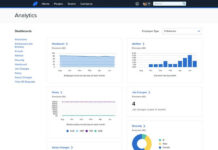
In this guest column, Mitrefinch Sales Manager Peter Bellotti details why HCM technology plays such a vital role in developing the modern workforce.
For any company to be successful, bringing in the right talent is an absolute necessity. Hiring the best people, however, is only half the challenge.
Finding strategies to manage talent in order to obtain maximum productivity and creativity to help a company grow and prosper is one of the main benefits that HR departments bring to businesses and organizations around the world. Human Capital Management is a specific approach to workforce staffing that identifies employees as a human capital asset whose value to a company can be enhanced through policies, training and supervision.
Unfortunately, Human Capital Management is often an underappreciated asset of a company or organization. This is part of the reason why over half of all U.S. employees are currently considering a new job, according to a recent Gallup poll.
The fact #HCM is often underappreciated is a big reason why over half of U.S. employees are considering a new job. #HR #HRTech #HCM @MitrefinchLtd Share on XObviously, high turnover rates represent an operational difficulty for any business or organization. In financial terms, a report issued by the Center for American Progress discovered that high employee turnover rates can cost organizations anywhere from 16 percent to 213 percent of the recently departed employee’s salary.
Human Capital Management can positively affect workforce management in a number of ways, and those positive effects filter through several diverse elements and functions within an organization.
Human Capital Management and IT
In today’s tech-savvy world, companies that don’t embrace full digitalization of the workplace and business operations are sure to face a competitive disadvantage. The digital revolution allows businesses to advance into new markets, engage with new employees and improve the overall efficiency of their operations. Furthermore, business digitization helps reinvent processes, improve quality and promote consistency across all area of the business.
The problem, of course, is that change can be hard. It requires that everyone within a company is on board. HR departments can play an important role in helping to bring in new talent that’s well-equipped to the digitalization of job tasks. In fact, most younger workers prefer companies that show a commitment to embracing the cutting edge technological trends. Furthermore, HCM can devise efficient training programs to help IT departments and other workers synchronize the transition to digital business operations.
Human Resources and Employee Management
Gone are the days of the simple time clock, when employees clocked in and clocked out of work on a daily basis. Today, successful employee management procedures require a more proactive approach that will help companies obtain maximum efficiency and productivity from their workforce. To name just one example, implementing time and attendance software is an important strategy to help companies and their employees maintain a transparent relationship.
In addition, the employee management procedures and policies set in place by HR help organizations implement seamless guidelines for employee sick days, PTO and other leave management tools. These guidelines can be directly connected to finance and payroll departments, making for a smooth and continuous payment schedule that helps companies avoid payment conflicts and the need to outsource payroll operations.
Efficient software-based systems can also be put in place to allow employees to request time off, thus making it easier for shift managers to oversee their workforce and make sure necessary tasks are accomplished on time. Instead of micromanaging every employee request, HR can also implement software programs that allow employees to switch shifts with other co-workers, thus allowing for more flexibility in the workplace without compromising the efficiency of business operations.
Strategic HCM Techniques Encourage a Mobile, Global Workforce
In today´s competitive, globalized economy, the companies that succeed are often those who are able to hire, train and maintain a competent, global workforce. Instead of setting up expensive offices around the world, cloud-based technology makes it easy for companies to hire and work with employees overseas. For example, a New York-based company might be able to hire a salesperson in New Delhi to work directly with local clients. Not only does this reduce operational costs, but this perk can also be a marketing tool to attract high quality talent. According to one report, businesses and organizations that offer remote work have a 25 percent lower turnover rate.
Managing a remote workforce comes with its own set of challenges. However, HR can help to device transparent methods for managing remote employees, including the use of computer-based biometric scanners, hourly time tracking through computer screenshots and other innovative processes.
HR and Effective Onboarding for Employee Retention
The Allied Workforce Mobility Survey recently found that businesses lose one out of every four workers within a year of hiring. The first weeks and months are critical to integrate an employee into business operations and help them find ways to offer their talent toward fulfilling long-term company goals. In fact, SHRM found that 69 percent of workers will stay with a company for three years or more if they experience a great onboarding process.
HR can implement structured onboarding programs that help new employees become engaged with the company. This obviously helps employees make for a smooth transition into the business operations they’re involved with.
Aligning Human Capital with Business Strategy and Goals
Lastly, and perhaps most importantly, Human Capital Management also plays a vital role in advancing business strategy and the goals set forth by senior management. Dynamic and motivated HR professionals can collaborate with management to determine the company´s long term objectives and the employee skills and abilities needed to move toward them.
Once the profile of an ideal workforce has been determined, today’s HR can use cutting-edge technological tools to capture and analyze data related to the type of people who are applying for jobs and which job ads will most likely pique the interest of candidates who would benefit the company.
Human Capital Management is often disregarded, especially by smaller companies that argue that they don’t have the resources to dedicate to a specialized HR department. However, HCM can positively affect businesses and organizations in several different ways, thus leading to a more efficient and prosperous future.
Peter Bellotti specializes in database technology, security, cloud and big data solutions. He is currently a sales manager at Mitrefinch, a global provider of Employee Management Systems and HR Solutions in the U.S., Canada, the UK and Australia.
Sign up for our newsletter here.
Image: 123RF
Guest columns are sponsored content and adhere to the HCM Technology Report’s editorial guidelines. They do not necessarily reflect the opinions of the editors.
















